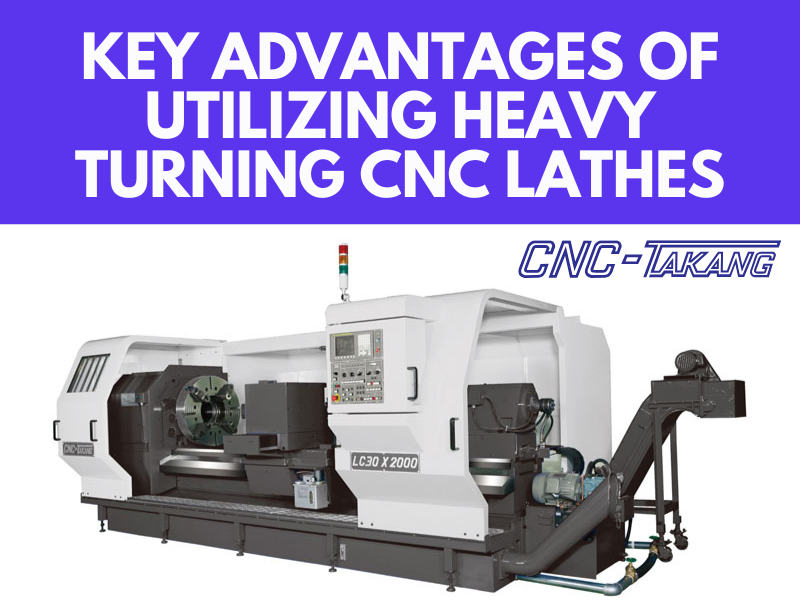
Blog
Key Advantages of Utilizing Heavy Turning CNC Lathes
In today's demanding machining environment, precision, stability, and the ability to handle large components are essential. For industries such as aerospace, energy, shipbuilding, and heavy equipment manufacturing, a heavy turning CNC lathe plays a critical role in ensuring consistent quality and production efficiency.
At CNC-TAKANG, we understand the complexity and challenges involved in heavy-duty turning. That's why we offer a wide range of robust CNC lathes engineered to deliver high performance, reliability, and long-term value. In this article, we highlight the core advantages of heavy turning CNC lathes and how they can elevate your production capabilities.
1. Exceptional Rigidity for Heavy-Duty Machining
Heavy turning CNC lathes are designed with reinforced machine beds and wide guideways to withstand extreme cutting forces. Their robust structural design minimizes vibration, which is crucial for achieving stability during deep cuts or when machining large-diameter, high-strength materials. This rigidity ensures consistent dimensional accuracy and longer tool life.
2. High Precision for Oversized Workpieces
Large workpieces present unique challenges in maintaining accuracy across the entire turning length. Heavy-duty CNC lathes address this with precision-ground slideways, balanced spindle systems, and high-resolution servo controls. These features enable consistently tight tolerances and fine surface finishes, even on parts exceeding several meters in length.
3. Increased Productivity with CNC Automation
Modern CNC control systems allow for efficient, repeatable machining operations. Operators can pre-program complex turning cycles, multi-pass operations, and threading sequences, drastically reducing manual intervention. Integrated features like automatic tool changers, programmable spindle speeds, and real-time diagnostics help boost cycle efficiency while reducing error and setup time.
4. Versatile Capabilities for Complex Machining
Heavy turning CNC lathes offer more than just basic turning. With the addition of live tooling, C-axis functionality, tailstocks, and steady rests, these machines can perform a wide range of operations—including boring, grooving, drilling, and profiling—all in one setup. This versatility supports both high-volume production and low-quantity, high-mix part runs.
5. Long-Term Reliability and Lower Cost Per Part
Durability is a key advantage of heavy-duty CNC lathes. Built with rugged materials and precision components, these machines are designed for continuous operation in demanding environments. Their low maintenance requirements, combined with consistent performance, result in a lower total cost of ownership and improved return on investment over time.
How to Choose the Right Heavy Turning CNC Lathe for Your Application
Selecting the right heavy turning CNC lathe is crucial to maximizing efficiency and achieving optimal machining results. To make the best investment, consider the following key factors:
- Workpiece Size and Weight
Ensure the machine's swing diameter and turning length can accommodate your largest parts. Flat-bed designs typically support longer workpieces, while slant-bed designs may offer better chip removal and access for automation.
- Material Type
If you're machining hard alloys such as stainless steel, forged steel, or cast iron, make sure the lathe has sufficient spindle power and rigidity to handle aggressive cuts without compromising precision.
- Required Precision and Surface Finish
Applications like turbine components or bearing housings demand tighter tolerances. Look for machines with precision-ground ways, stable spindle bearings, and fine servo control for consistent finish quality.
- Optional Features and Automation Needs
Consider whether your operation requires live tooling, C-axis functionality, steady rests, or bar feeder integration. These options significantly expand the lathe's capabilities and may reduce the need for secondary operations.
By clearly identifying your production goals and machining requirements, you can choose a lathe that not only meets today's needs but also supports future growth.
Why Choose CNC-TAKANG for Heavy Turning CNC Lathes?
At CNC-TAKANG, we have over 50 years of experience developing CNC turning solutions for demanding industrial applications. Our heavy turning CNC lathes—available in both flat-bed and slant-bed configurations—are built for strength, precision, and longevity.
Key product advantages include:
- Extra-wide cast beds for improved rigidity and stability
- High-torque gear-driven spindles for demanding cuts
- Support for steady rests, follow rests, and automation options
- Advanced CNC control integration for streamlined operations
- Comprehensive quality inspection before every shipment
Our machines are trusted by manufacturers worldwide for their performance in critical applications such as turbine shafts, flanges, pipe threading, and large-scale components. Whether you're scaling up production or upgrading your machining capabilities, CNC-TAKANG delivers solutions that meet your exact needs.
Conclusion
Heavy turning CNC lathes are essential for any operation that deals with large, complex, or high-strength components. Their combination of structural rigidity, machining precision, automation compatibility, and durability makes them a smart investment for long-term manufacturing success.
Ready to take your heavy-duty machining to the next level?
Explore CNC-TAKANG's full line of Heavy Turning CNC Lathes, or contact our team for personalized recommendations based on your specific application.

